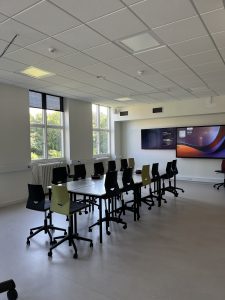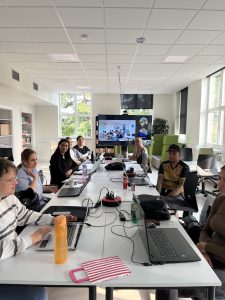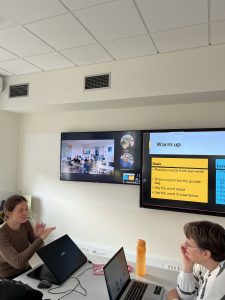Indretning af hybride lokaler - Didaktiske overvejelser VUC
Needs in infrastructure, Building the infrastructure, Designing a hybrid Classroom, Testing, Action plansDesigning hybrid learning space
By Camilla Holck Hemmingsen and Susanne Djurhuus, teachers at VUC Storstrøm
In the hybrid learning space, teaching takes place across locations. The teacher is located in one city in a hybrid classroom with attending students. At the same time students have appeared in another city and participate synchronously in the teaching from their classroom. It is also possible to connect from home. Everyone can see and hear each other in real time. The academic content, didactics, the opportunity for group work and dialogue with the teacher, etc. are made possible by the digital solution – everyone participates on equal terms in this way. The teacher also alternates between the locations, to give all students the experience of having a teacher in their own classroom. This is especially important for building relationships and to give individual feedback. In this way, parallel teaching is an extended learning space.

Interior design of the premises in Vordingborg
The classroom contains different learning zones making it possible to work based on different didactic principles and learning strategies. At the centre of the room is the “main table”, where joint activities such as presentations, debates, rehearsals, quizzes and much more take place. At the main table, all students can see each other and the teacher regardless of location, and the teacher can also see all students. All students get their information from the screens next to the teacher. Here there are two screens, one for the academic content and one for relationships and communication (the screen of the camera).
The teacher uses the screen at the back of the room to see the attending students. It makes it look like an extension of the classroom. This way, you avoid the teacher standing with his or her back to the students who have physically turned up at the teacher’s location.


We have tested several table setups to ensure security and collaboration across locations and have ended up with a central table in the middle being the optimal set-up. In this way, all students are within the camera angle, which gives the feeling of a unified class across locations. They can interact with each other, no matter where they are located.
On the other hand, it has also been important for us to create good learning environments outside the cameras. We have established this with our sound-lowering sofas and a high collaboration table. Here, the students can work individually and with group assignments. They can still see the screens but have moved away from microphones and cameras. There is also a group table within the camera and microphone range, for students who wish to keep contact with other students.
The room is also furnished with book shelves, like a small library, where the students also have the opportunity to provide themselves with analogue material for teaching and for individual reading.
Principles of learning
It is our experience that you can reach the same learning goals in hybrid learning as in a regular classroom, but you also learn more. In the subject didactics, digital education is also taken into account. It is not something the students know from the beginning, but they learn it while they learn the academic content. Our students usually have a low IT level, and this is where our didactics take its starting point.
The hybrid classroom requires a new didactisation. Clear structure, digital tools and signs of learning are keywords. To make signs of learning visible, several digital tools such as Padlet, White Boards and quizzes are incorporated. Common to all is that the material can be accessed regardless of location, and the students can work together in real time.


In Teams Class Notebook, the collaboration area is used for shared notes, and larger group work can also be shared with each other here. The students discover that they can continue to work on each other’s ideas, and the notes are less polished than the completed assignments that are handed in, and this gives the teacher a clear understanding of the process. Here you have the opportunity to give feedback, feed up and feed forward.
In the Class Notebook’s individual access area, the student and teacher collaborate, and here feedback is quickly given on specific assignments and learning processes. This provides a dynamic collaboration, where the teacher not only sees the finished product, but the process and can correct and provide with input along the way. It also gives the teacher great opportunities to zoom in on the individual student, and it helps to create relationships across the screens.
Both the collaboration area and the individual area give the teacher good opportunities to avoid that someone has misunderstood an assignment, as you can follow the process along the way. The students also have the opportunity to use the common notes in relation to future assignments and as notes for exams.
The hybrid classroom requires a clear structure and frequent change of inputs. The students must know what to do when, how to participate in the group work and which tools to use. Therefore, it is an advantage if a module is built relatively simple and follow the same structure each time.


